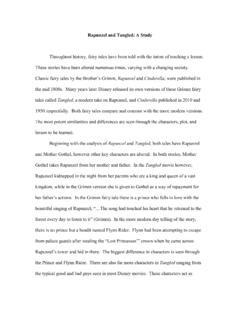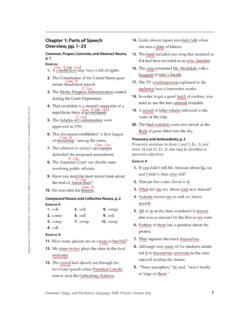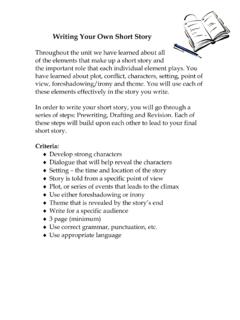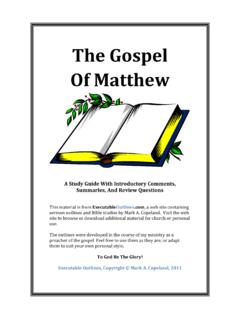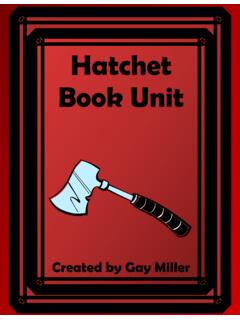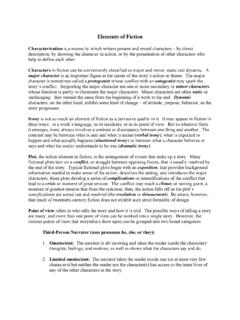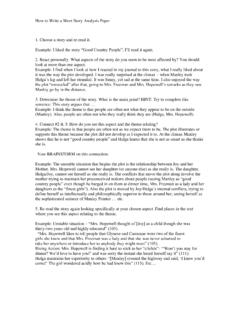Transcription of Literary Elements Handout The following are literary ...
1 1 (for fiction and nonfiction) 1. CHARACTER This is a person, animal, or an object in fiction or drama. Characters are described, or characterized, based upon their personalities, actions, appearance, and thoughts. There is a main character [protagonist] who is the most important character in a story and sets the plot in motion, and there are minor characters who are not as important to the plot as the main character. The character who blocks the protagonist or (main character) is called the antagonist. Sometimes the antagonist is a villain who is a person, but an antagonist can also be a force (like nature) opposing the main character.
2 Characters that change throughout the Literary text are dynamic or round, while characters that do not change are referred to as static or flat. - Characterization is the means by which writers reveal character. A quality that a character exhibits is called a character trait. This trait can be indicated by the character's statements, actions, or thoughts. For example, Bella Swan is characterized as an independent, open-minded, vampire-liking, teenager trying to fit in at Forks High School. Character motivation is the reason he/she takes a particular action. Motive, or motivation, is what drives a character to think, behave, and interact with others in a way that is specific to his/her traits.
3 - Keep in mind that an author may create a fictitious character by: simply describing the character the character s speech or actions. giving the reactions and opinions of other characters. showing the character's inner thoughts and feelings. 2. CONFLICT This is a central problem around which a story revolves. There are 2 types of conflict that can occur: (1) Internal conflict occurs within a person or character (2) External conflict occurs between a person & another person, a machine, nature, or society. Conflict is necessary to every story. In short stories, there is usually one major conflict.
4 In longer stories, there could be several conflicts . Conflict adds excitement and suspense to a story. The conflict usually becomes clear at the beginning of a story (in the exposition). As the plot unfolds, the reader starts to wonder what will happen next and how the characters will handle the conflict. Many readers try to predict the final outcome (some even cheat and read the last few pages first because they can t stand the suspense boooooo!). 3. SETTING This is the time and place in which a story takes place. Details of a setting include: 2 - Time/Historical Period the general period of the plot and the main location of the story (ex the story took place during the 1960's at Woodstock) - Physical Features what the place/location of the setting looks like physically (ex mountains, streams and fields of grass) - Geographic Location the actual location of the place (ex the story took place in China Town of NYC) 4.
5 plot (or Narrative Arc) This is the series of events that make up the story or drama/play. The parts of plot are: Exposition, Rising Action, Climax, Falling Action and Resolution/Denouement. - Exposition Here readers are exposed to information that will later be necessary for them to have if they are to understand the unfolding story. It is the part of a work of fiction where readers learn about the characters and the conflicts they will experience. It is sometimes referred to as the basic situation; it provides needed background information. - Rising Action - Usually, there is no clear boundary between exposition and rising action; rather, there is a gradual merging of the two.
6 In this section of the story, complications emerge and eventually a dominant conflict becomes clear. The range of conflicts looks like this: 1. In early literature, the conflicts were Man vs. Man, Man vs. Nature, and Man vs. Self. 2. As fiction evolved and psychological theories, technological advances, and urbanization occurred, the list expanded to include Man vs. Society, Man vs. Technology, and Man vs. Alter Ego. 3. In the age of film, these others exist, but as the 20th century unfolded, the list expanded yet again. Today, we add Man vs. Alien Society, Man vs. Biotechnology, and Man vs. Cloned Self to the ever-growing list - Climax or the turning point of the action; this is usually where the main character makes the single big decision that defines the outcome of their story and who they are as a person.
7 The climax often contains much of the action in a story, for example, a defining battle. - Falling Action - This is the part of the plot that occurs after the climax has been reached; it is the part where loose ends are tied up and leads to the resolution of the conflict. 3 - Resolution This is the solution to the conflict. It is often called the denouement or how the story ends. 5. FORESHADOWING This is clues in the text that hint as to things that will happen later in the plot . Foreshadowing is usually more subtle and works on the symbolic level. For example, if a character must break up a schoolyard fight among some boys, it might symbolically foreshadow the family squabbles that will become the central conflict of the story.
8 You usually can find foreshadowing anywhere from the exposition to the falling action 6. FLASHBACK - are interruptions that writers do to insert past events in order to provide background or context to the current events of a narrative. 7. POINT OF VIEW (POV) The voice telling the story is the narrator. Point of view refers to the voice in which the story is told. It is the set of eyes the author uses to let the reader see the action unfold. Of the three, first and third persons are the most commonly used in writing stories: - First-Person One can spot first person point of view by the pronouns I, we, & us.
9 With the use of first person, the narrator is an actual character in the story. His or her knowledge is, therefore, limited to that one person s perspective. - Third-Person When writing in third person, the narrator uses names of characters & pronouns like he, him, she, her, they, & them. If the narrator relates thoughts of only one character in the story, it is third person limited, as in limited to the knowledge of the thought process for that one character. In third person omniscient point of view, the narrator knows and relates not only the action of all characters in the story, but of each character s thoughts as well, thus the term omniscient or all-knowing.
10 - Second-Person A narrator using second person is rather rare. The pronoun you is used in this type of writing. An example follows: You feel the salt air on your skin. You feel alone and isolated on the beach; yet, you feel deep inside of yourself that you are not alone. This POV is typically used in self-help books or advice columns. 8. SPEAKER This is the person delivering the story. Remember, the speaker and the author are not necessarily one in the same. For example, in Langston Hughes (male) poem Mother to Son, the speaker is actually his mother, not him. 9. NARRATOR This is a person who recounts the events of a novel or narrative poem.
